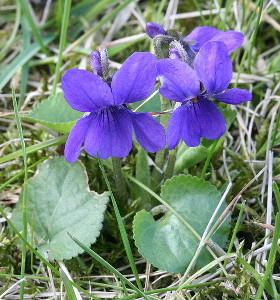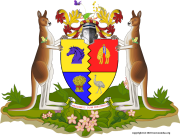
Updated 03/05/2024
Toowoomba's floral emblem, the Viola Odorata is a species of the genus Viola. Commonly known as the Sweet Violet it actually is a European native. It's significance to Toowoomba and hence it being known around Toowoomba as the 'Toowoomba Violet' can best be explained by the following extraction that was found on Jean Ann French's Blog.
Toowoomba Violet – Floral Emblem Viola Odorata “Princess of Wales” commonly known as the “Sweet Violet”
The violet was declared Toowoomba’s Floral Emblem at a meeting of Council on 11th January 1932. the mothers and other family members of the lads who went to war in 1914-1918, picked and sold bunches of violets to raise funds. the bunches each held 50 blooms and three leaves, tied with cotton and were sold for threepence. 1800 pounds were raised to build the Mother’s Memorial now located in East Creek Park.
Characterised by it's sweet scent, heart shaped leaves, and vibrant violet colour, there is more to the Toowoomba Violet than first meets the eye.
Besides it superficial attributes the Viola Odorata has other applications. It has long been known for it's alternative medicinal properties which is commonly used for the treatment of respiratory conditions like sore throats. Other medicinal aspects of the plant are also being studied from a scientific perspective.
The Viola Odorata's usefulness continues, where in cooking the flower can also be used as an ingredient in salads and for decorative purposes . It's cooking practicality is not just limited to the flower but in fact every part of the plant can be used. Tea, for example can be made from using the whole plant.
From a symbolic point of view, the Sweet Violet's significance goes as far back as Ancient Greece where the plant was linked with love and romance.
Sweet violets (scientific name: Viola Odorata) are a beautiful wildflower that is native to much of Europe, Western Asia and India, but an introduced species in countries like North America, Australia and South Africa. They are so named because of their sweet scent and violet colour. The sweet violet is similar to the common blue violet (scientific name: Viola Sororia). Sweet violets are a genius of flowering plant (which includes pansies) in the violet Violaceae family.
Sweet violets are a perennial plant, and they like growing in partially shaded areas in soil that is moist, locations like gardens, forest edges, walking trails/tracks.
The plant first blooms in spring, producing colourful shades of blue and purple (usually dark purple, but occasionally also lilac and white). The flower consists of five petals not fused together. Two upper petals are splayed back, and two side ones are like wings (the four upper petals have a cross formation) and the fifth petal is the lower one and has dark veins at the throat of the flower, and forms a long narrow tube called a spur in the back of where there is nectar. The fertile flowers are hidden and only develop in autumn and they don't open and self pollinate. The pant spreads out in a formation known as a basil Rosette. Since the flowers usually hide under the leaves, the leaves can be thinned out so that the flowers can be revealed.
The Sweet violet produce seeds in pods that can be harvested once the flowers have faded and the seed pod swells. Once the pods are brown they can be cracked open. Once the seeds have been collected it is best to let them dry for a day or two. They should be stored in a cool, dry dark location away from direct sunlight.
The leaves have rounded teeth, are heart shaped, and rounded at the tip. The leaves do not have a stem, but rather a petiole that has a short hair like texture. The leaves are present all year round.
Sweet violets are a low growing herb, rising between 5-15 centimetres in height and spread out via asexual reproduction through a process called vegetative reproduction. This involves a new plant growing from the old plant, which is possible due to sweet violet rhizome and stolens (also called runners) that are modified stems that help the plant spread out. Ants also aid in propagation by spreading the seeds of the sweet violet.
The flowers and leaves of sweet violets can be consumed raw but the roots should not be consumed. The plant have many medicinal uses including used in a tea to aid in relaxing and soothing anxity.
When foraging for sweet violets, plant familiarisation is important and identification should be with 100% certainty as lookalikes can be toxic, and the areas they grow in may have the possibility of contaminated soil.
Due to methyl salicylate content the plant should not be consumed by people who are allergic to salicylates (found in asprin), or glucose 6-phosphate dehydrogenase deficiency.
To discover further useful information about this amazing plant that is the 'Toowoomba Violet' one only has to search online for 'Toowoomba Violet', 'Sweet Violet' or 'Viola Odorata'.
Useful Links: Viola Odorata.




